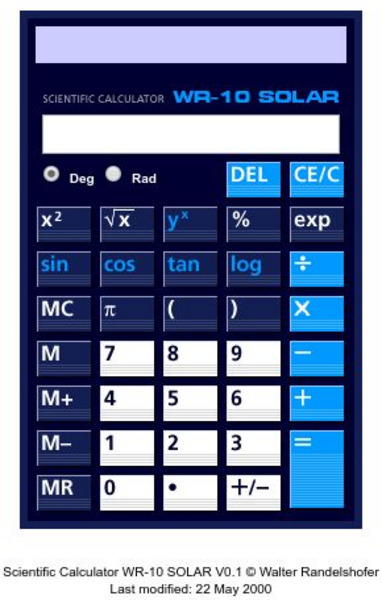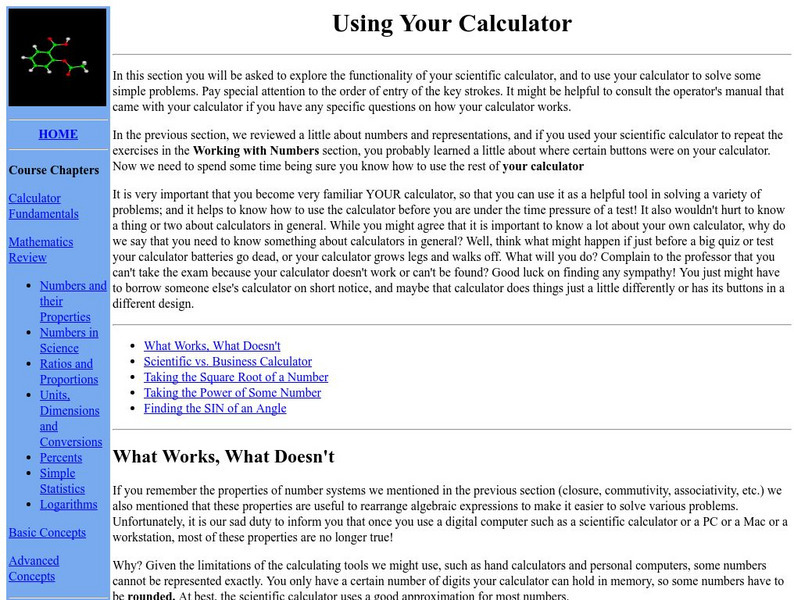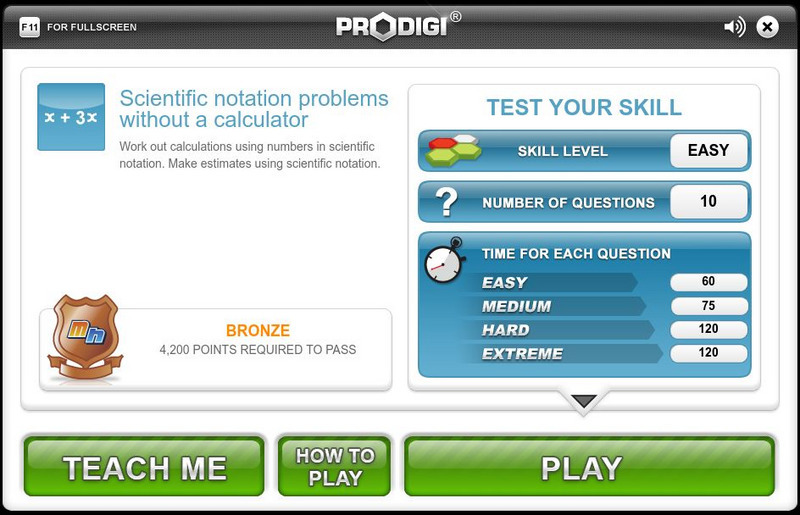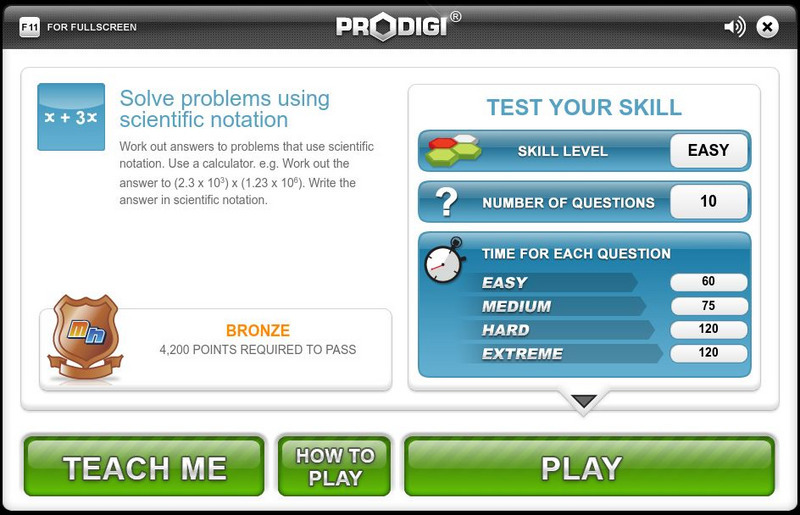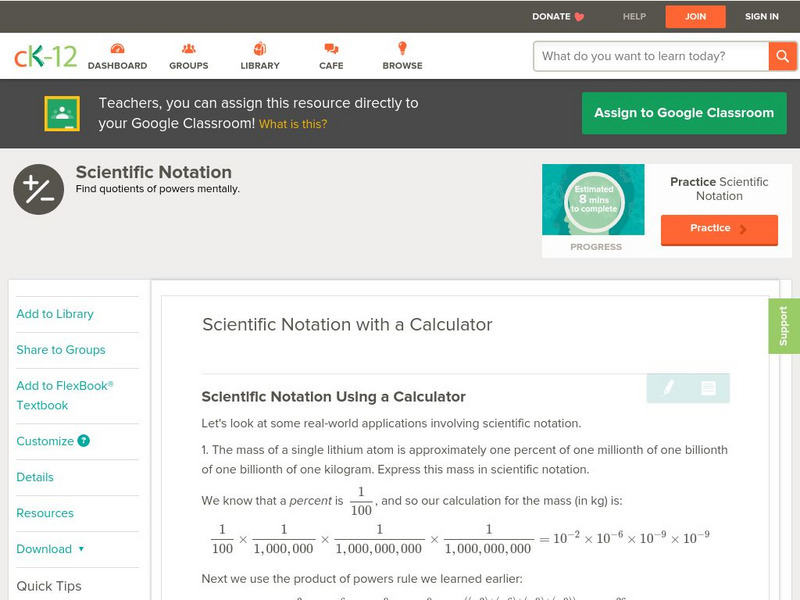Hi, what do you want to do?
Curated OER
Lung Limit
Learners determine their lung capacity by completing a science experiment with a bottle of water. In this lung science lesson, students discuss the lungs' purpose. Learners complete an experiment to determine their lung capacity using a...
Curated OER
How BIG is 400?
Students solve problems using dimensional analysis. In this chemistry lesson, students choose a problem and present it in class. The rest of the class will evaluate the solved problem on the board.
Curated OER
Teaching Place Value
Utilizing mathematical literature and games are two excellent ways to introduce and teach place value.
Science Struck
Science Struck: How to Use a Scientific Calculator
Presents detailed explanation of how to use the different key functions on a scientific calculator. Each function is accompanied by example problems with the steps for finding the solutions using the calculator. Includes diagram of...
Math Open Reference
Math Open Reference: Math / Scientific Calculator
This online scientific/math calculator supports functions for algebra and trigonometry. Operates using both the keys on the computer keyboard or pressing the keys on the calculator with the mouse or a combination of both.
Other
Randelshofer / Online Scientific Calculator
This is an online scientific calculator! Just type as if you were using a handheld calculator. Includes trigonometric functions, degrees, radian modes and other useful functions.
Other
Demos: Scientific Calculator
Learn how to use the Desmos scientific calculator. Watch a video demonstration and review pro tips to understand unique features and shortcuts to use with this calculator.
Calculator Soup
Calculator Soup: Descriptive Statistics Calculator
This is a statistics calculator; enter a data set and hit calculate. Descriptive statistics summarize certain aspects of a data set or a population using numeric calculations. Examples of descriptive statistics include: mean, average,...
Other
Square Box Systems Ltd: Scientific Calculator
A useful tool for any student who needs a scientific calculator.
Texas Instruments
Texas Instruments: Divisibility Rules! Using Scientific Calculators
Concepts and skills covered in this activity include number theory, divisibility rules, multiples, factors, and problem-solving skills.
TED Talks
Ted: Ted Ed: How Simple Ideas Lead to Scientific Discoveries
Educator, Adam Savage, shares two astounding examples of profound scientific discoveries that came from simple, creative procedures: Eratosthenes' calculation of the Earth's circumference and Hippolyte Fizeau's measurement of the speed...
Shodor Education Foundation
Shodor: Using Your Calculator
This site deals with using a calculator to help solve and evaluate mathematical problems. This site provides a lengthy chart of basic operations performed by calculators, examples of problems to be solved using a calculator, as well as...
Texas Instruments
Texas Instruments: Calculator Help
A list of the most frequently asked questions by new users, teachers and students. Originally authored to help teachers who weren't familiar with the calculator to enable them to quickly help a student who was "stuck".
Mangahigh
Mangahigh: Number: Scientific Notation Problems Without a Calculator
Test your knowledge of scientific notation.
Varsity Tutors
Varsity Tutors: Hotmath: Graphing Calculator Practice Problems Number Theory
Practice using your graphing calculator for number theory problems, including prime factorization, greatest common factor, least common multiple, and scientific notation. If you get stumped or if you would like to check your work, then...
Mangahigh
Mangahigh: Number: Solve Problems Using Scientific Notation
Understand how to imterpret scientific notation on a calculator.
Varsity Tutors
Varsity Tutors: Hotmath: Graphing Calculator Practice Problems: Factoring
Practice using your graphing calculator for solving exponent problems and factoring polynomials. If you get stumped or if you would like to check your work, then select the View Solution button, which is located directly under each problem.
CK-12 Foundation
Ck 12: Algebra: Scientific Notation With a Calculator
[Free Registration/Login may be required to access all resource tools.] Apply scientific notation concepts using a calculator to solve real-world problems.
CK-12 Foundation
Ck 12: Algebra: Scientific Notation With a Calculator
[Free Registration/Login may be required to access all resource tools.] Evaluate scientific notation on a calculator.
CK-12 Foundation
Ck 12: Physical Science: Calculating Derived Quantities
[Free Registration/Login may be required to access all resource tools.] Definition of derived quantity and calculation and units of derived quantities (area, volume, density).
CK-12 Foundation
Ck 12: Physical Science: Calculating Derived Quantities
[Free Registration/Login may be required to access all resource tools.] Definition of derived quantity and calculation and units of derived quantities (area, volume, density).
Calculator Soup
Calculator Soup: Scientific Notation Calculator
Use this calculator to add, subtract, multiply and divide numbers in scientific notation, E notation, or engineering notation. Answers are provided in three formats: scientific notation, E notation, and engineering notation.
US Energy Information Administration
U.s. Eia Energy Kids: Energy Calculators
A series of useful calculators for converting different sources of energy from one energy unit to another. Find conversion calculators for coal, electricity, natural gas, crude oil, gasoline, and diesel fuel, along with an additional...










